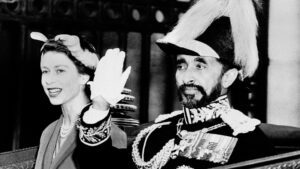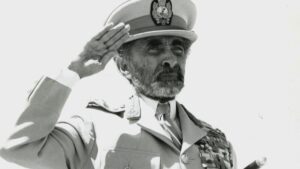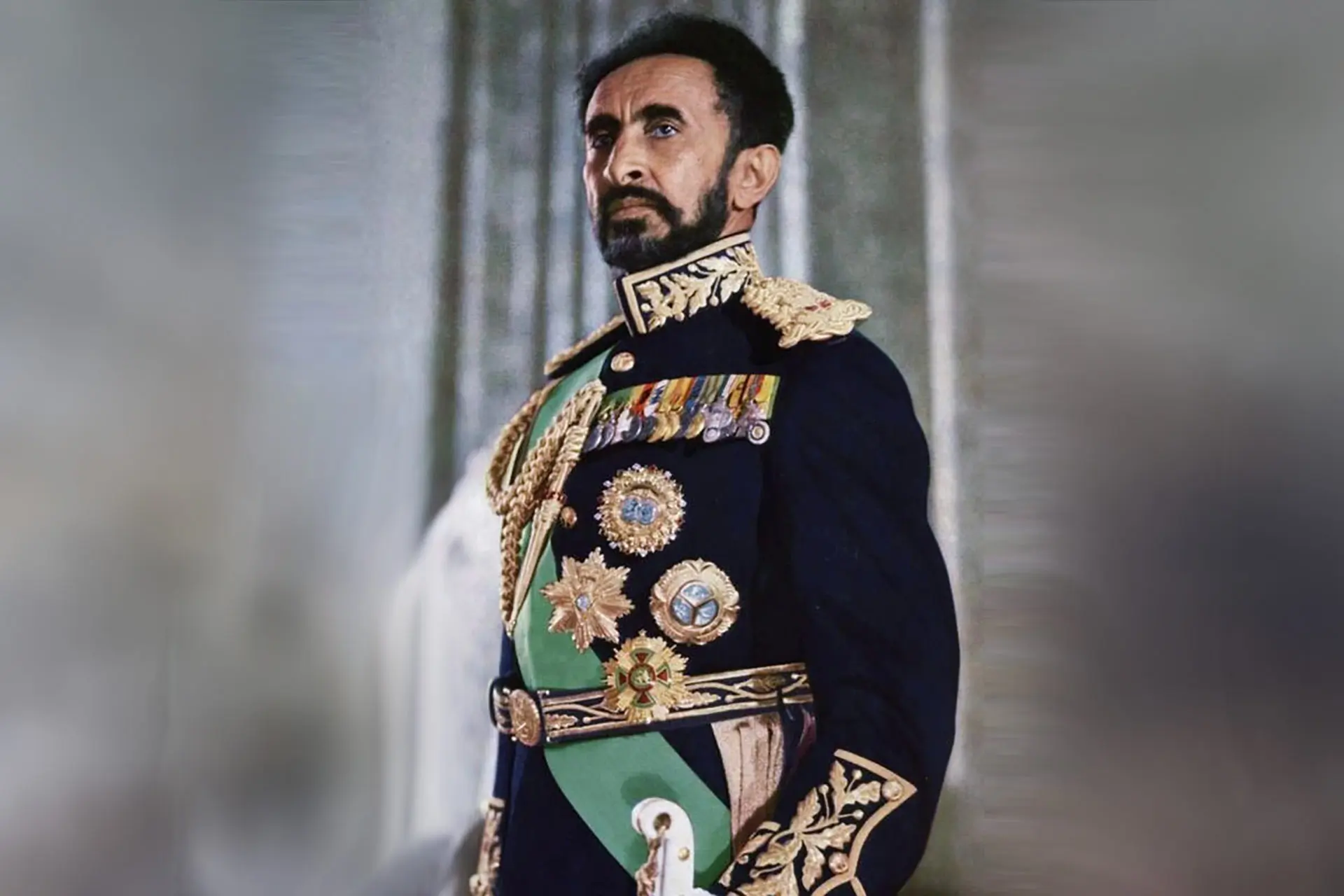Who Is Haile Selassie?
Who is Haile Selassie?
Haile Selassie, born as Tafari Makonnen, was the Emperor of Ethiopia from 1930 to 1974. He was a pivotal figure not only in Ethiopian history but also on the world stage. Haile Selassie is perhaps best known for his role in resisting the Italian invasion of Ethiopia in 1935 and for his impassioned plea for help at the League of Nations in 1936, where he condemned the lack of action to stop the aggression.
Born on July 23, 1892, in Ejersa Goro, Ethiopia, Haile Selassie was named Ras Tafari Makonnen. He ascended to the throne as Emperor Haile Selassie I following the death of Empress Zewditu. His official titles included “King of Kings,” “Lion of Judah,” and “Elect of God” – titles that would later have profound significance in the Rastafari movement.
Haile Selassie was known for modernizing Ethiopia during his reign, introducing the country to the rest of the world while also preserving its rich cultural heritage. He implemented various reforms, such as the abolition of slavery and the introduction of the country’s first written constitution and legislature.
Internationally, Haile Selassie was a respected leader and statesman. He played a significant role in the formation of the Organization of African Unity (OAU), now known as the African Union, which aimed to promote unity and cooperation among African nations.
Despite his accomplishments, Haile Selassie faced challenges, especially towards the end of his reign. In 1974, he was deposed in a coup led by the Derg, a Marxist military junta. Haile Selassie died under mysterious circumstances in 1975, sparking decades of speculation and controversy surrounding the true nature of his death.
Haile Selassie remains a revered figure in Ethiopian history and beyond. His legacy continues to be a subject of admiration, debate, and inspiration, particularly among those who view him as a symbol of African independence, sovereignty, and cultural pride.
Haile Selassie’s Legacy and Impact on Ethiopia

Haile Selassie, also known as Ras Tafari, served as Ethiopia’s regent from 1916 to 1930 and Emperor from 1930 to 1974. His reign had a profound impact on Ethiopia, shaping the country’s modern history and leaving behind a complex legacy that continues to be debated. As a visionary leader, Selassie implemented significant reforms aimed at modernizing Ethiopia, including the abolition of slavery, the introduction of a constitution, and the establishment of educational institutions.
One of Selassie’s most enduring legacies is his role in resisting Italian colonization during the Second Italo-Ethiopian War. Despite Ethiopia’s defeat in 1936, Selassie’s impassioned appeal to the League of Nations brought international attention to the plight of his country and inspired global support for Ethiopian independence. His triumphant return to Ethiopia in 1941 marked a symbolic victory for anti-colonial movements worldwide and solidified his reputation as a symbol of African resistance against imperialism.
Selassie’s modernization efforts extended to various sectors of Ethiopian society, including infrastructure development, healthcare, and education. He implemented projects to improve transportation networks, healthcare facilities, and educational institutions, aiming to uplift the living standards of his people and foster national unity. Selassie’s emphasis on education led to the expansion of schools and universities across the country, promoting literacy and intellectual growth among Ethiopians.
Despite his achievements, Selassie’s legacy is also clouded by criticisms of his authoritarian rule and failure to address internal political and economic challenges. The famine of 1973-1974, which resulted in widespread starvation and loss of life, exposed the shortcomings of his government and eroded public confidence in his leadership. Growing discontent culminated in a coup in 1974 that led to Selassie’s overthrow and eventual death in custody the following year.
Haile Selassie’s legacy is a complex tapestry of achievements and controversies that continue to shape Ethiopia’s historical narrative. His unwavering commitment to Ethiopian sovereignty, modernization efforts, and global anti-colonial advocacy cemented his status as a revered figure in African history. However, criticisms of his rule and the tragic end of his reign underscore the complexities of his legacy and the ongoing debates about his impact on Ethiopia’s trajectory.
Haile Selassie’s Role in Pan-Africanism

Haile Selassie, also known as Ras Tafari, played a significant role in the Pan-Africanism movement during the 20th century. As the Emperor of Ethiopia from 1930 to 1974, he was a key figure in advocating for the unity and liberation of African nations from colonial rule. Selassie firmly believed in the importance of African solidarity and worked towards promoting cooperation among African states to combat imperialism and oppression.
One of Haile Selassie’s most notable contributions to Pan-Africanism was his involvement in the formation of the Organization of African Unity (OAU) in 1963. The OAU was established with the aim of promoting unity and solidarity among African nations and eradicating colonialism from the continent. Selassie’s efforts in spearheading the creation of the OAU demonstrated his commitment to Pan-African principles and his vision for a united and prosperous Africa.
In addition to his diplomatic initiatives, Haile Selassie was also a vocal advocate for African independence on the global stage. He addressed the League of Nations in 1936 to denounce the Italian invasion of Ethiopia, making a powerful plea for collective security and the respect of sovereign nations. Selassie’s impassioned speech earned him international recognition and solidified his reputation as a champion of African sovereignty.
Furthermore, Haile Selassie supported liberation movements in various African countries, providing both moral and material assistance to freedom fighters seeking to overthrow colonial regimes. His backing of anti-colonial struggles in countries such as Kenya, Algeria, and South Africa cemented his status as a leading figure in the fight against imperialism and injustice.
Despite facing challenges and criticism during his reign, Haile Selassie’s commitment to Pan-Africanism remains a significant part of his enduring legacy. His efforts to promote African unity, independence, and self-determination continue to inspire generations of activists and leaders in Africa and beyond. Haile Selassie’s role in Pan-Africanism serves as a testament to his enduring impact on the history and collective consciousness of the African continent.
Haile Selassie’s Influence on the Rastafari Movement
Haile Selassie, also known as Ras Tafari, plays a significant role in the beliefs and practices of the Rastafari movement. Born as Tafari Makonnen in Ethiopia in 1892, he was crowned Emperor Haile Selassie I in 1930. Rastafarians view Haile Selassie as the messiah and believe him to be the living God incarnate. This belief stems from Marcus Garvey’s prophecy, which proclaimed, “Look to Africa, where a black king shall be crowned, he shall be the Redeemer.” Haile Selassie’s coronation seemed to fulfill this prophecy, leading many to see him as the promised savior.
The Rastafari movement, which emerged in Jamaica in the 1930s, draws inspiration from Haile Selassie’s words and deeds. His speeches calling for freedom, equality, and unity among all people resonated with Rastafarians, who saw him as a symbol of black pride and resistance against oppression. The Emperor’s defiance against European colonization in Africa and his advocacy for African unity deeply influenced the Rastafari belief in repatriation to Africa.
One of the most iconic connections between Haile Selassie and the Rastafari movement is the concept of Zion. Rastafarians often refer to Ethiopia as Zion, believing it to be their spiritual homeland and a place of salvation. For them, Haile Selassie’s coronation solidified Ethiopia’s significance as a sacred land, further strengthening their resolve to return to Africa.
Despite Haile Selassie’s initial reluctance to embrace the godlike status ascribed to him by Rastafarians, he eventually acknowledged their reverence. In 1966, during his visit to Jamaica, he famously stated, “Today, I stand before you as a man,” a statement that Rastafarians interpret as his humility and recognition of their faith.
The Rastafari movement’s deep-rooted connection to Haile Selassie continues to thrive, with his image and teachings remaining central to their spiritual practices. Through his legacy as a respected African leader and symbol of black empowerment, Haile Selassie lives on in the hearts and minds of Rastafarians worldwide, inspiring them to uphold their faith and pursue social justice in his name.
In essence, Haile Selassie’s impact on the Rastafari movement transcends his role as a political leader, solidifying his place as a revered spiritual figure and the focal point of Rastafarian beliefs. His legacy endures through the ongoing devotion of Rastafarians who view him as the embodiment of divine love, unity, and liberation for all oppressed peoples.
Controversies and Criticisms Surrounding Haile Selassie
Haile Selassie, the former Emperor of Ethiopia, is a figure shrouded in both reverence and controversy. While he is celebrated by many as a visionary leader and a symbol of African unity, there are also several controversies and criticisms surrounding his reign.
One of the major criticisms against Haile Selassie is his handling of the Ethiopian economy. During his rule, Ethiopia experienced significant economic challenges, with issues such as widespread poverty, famine, and a lack of modernization plaguing the country. Critics argue that Haile Selassie’s focus on maintaining power and traditional institutions led to neglect of crucial economic reforms that could have uplifted the nation.
Another contentious aspect of Haile Selassie’s legacy is his approach to political dissent and human rights. His regime was accused of suppressing political opposition through censorship, surveillance, and violent crackdowns on dissenters. The Emperor’s centralized rule and authoritarian tendencies have drawn criticism from human rights activists and historians, pointing to instances of political repression and abuse of power during his reign.
Furthermore, Haile Selassie’s response to regional autonomy movements within Ethiopia has been a subject of debate. Critics argue that his government’s policies towards regions such as Eritrea and Oromia were often heavy-handed, leading to increased tensions and resistance from marginalized ethnic groups seeking greater autonomy and self-determination.
Moreover, Haile Selassie’s controversial decision-making during key historical events, such as Ethiopia’s conflict with Italy during the Second Italo-Ethiopian War and his response to internal uprisings, has sparked debates among historians and scholars. Some view his actions as strategically astute, while others criticize his leadership for its perceived shortcomings and failures to address pressing challenges effectively.
While Haile Selassie remains a complex and revered figure in Ethiopian and African history, it is essential to acknowledge the controversies and criticisms surrounding his rule. By critically examining his legacy, we can gain a deeper understanding of the multifaceted impact he had on Ethiopia and the broader African continent.
Conclusion
Haile Selassie, the former Emperor of Ethiopia, left a significant legacy and impact on his country and the world at large. His reign saw Ethiopia undergo modernization and become a member of the League of Nations and later the United Nations. Haile Selassie played a crucial role in advancing the cause of Pan-Africanism, advocating for unity and solidarity among African nations against colonialism and imperialism. His support for African independence movements and his efforts to promote African unity earned him respect and admiration across the continent.
The Rastafari movement, inspired by the belief that Haile Selassie was the messiah and the fulfillment of biblical prophecies, has had a profound impact on culture, music, and spirituality, particularly in Jamaica and other parts of the African diaspora. The movement’s message of African pride, resistance against oppression, and spiritual liberation continues to resonate with people around the world.
Despite his achievements, Haile Selassie was not without controversies and criticisms. His authoritarian rule, suppression of dissent, and failure to address economic and social challenges in Ethiopia led to growing discontent among the population. The famine in the early 1970s, exacerbated by government mismanagement and corruption, tarnished his reputation both at home and abroad. His overthrow in 1974 marked the end of centuries-old monarchy in Ethiopia and ushered in a period of political turmoil and instability.
However, Haile Selassie’s legacy endures, with many Ethiopians remembering him as a visionary leader who modernized the country and placed it on the world stage. His contributions to Pan-Africanism and advocacy for African unity continue to inspire generations of Africans to work towards a brighter future for the continent. The Rastafari movement, with its message of spiritual liberation and social justice, remains a living testament to the enduring influence of Haile Selassie’s legacy.
Haile Selassie was a complex figure whose impact reverberates through Ethiopian history, African politics, and global culture. His life and legacy continue to be studied, debated, and celebrated, highlighting the enduring relevance of his ideas and ideals in today’s world. Whether remembered as a visionary leader, a controversial ruler, or a spiritual figurehead, Haile Selassie’s influence on Ethiopia and beyond is indelible and deserving of further exploration and understanding.




